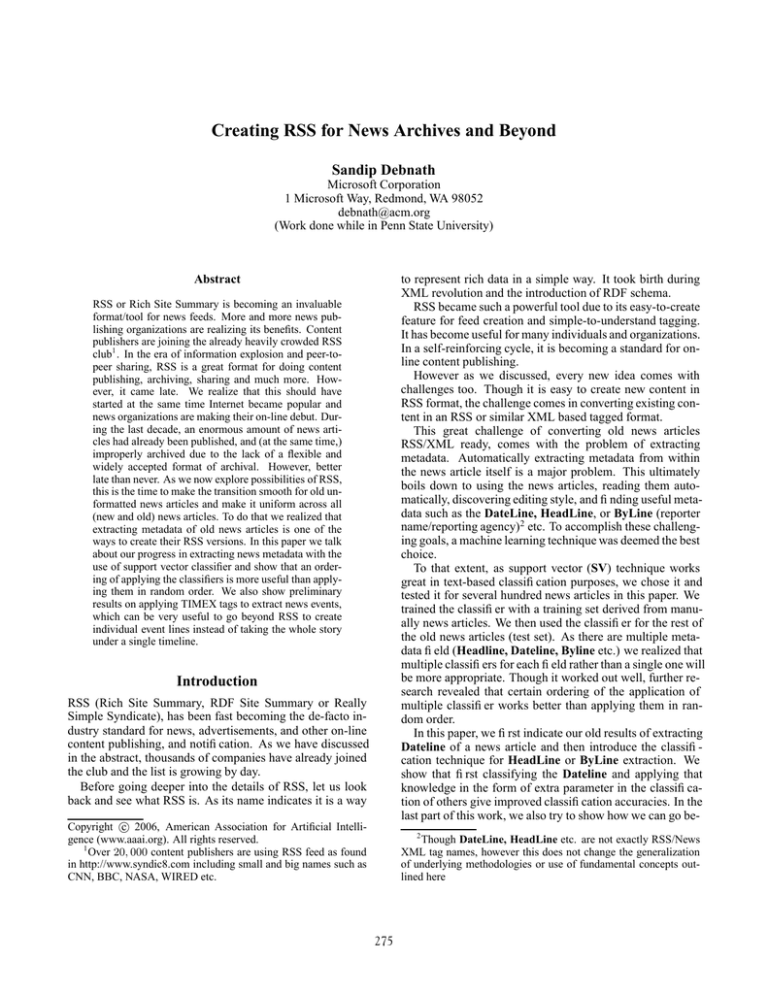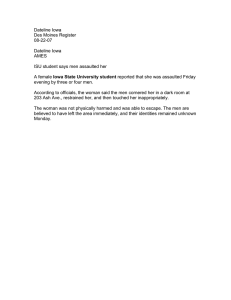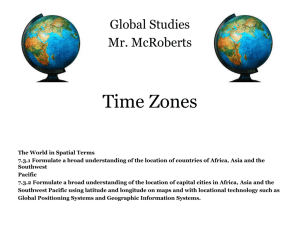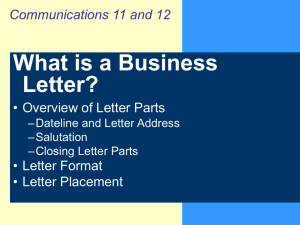
Creating RSS for News Archives and Beyond
Sandip Debnath
Microsoft Corporation
1 Microsoft Way, Redmond, WA 98052
debnath@acm.org
(Work done while in Penn State University)
to represent rich data in a simple way. It took birth during
XML revolution and the introduction of RDF schema.
RSS became such a powerful tool due to its easy-to-create
feature for feed creation and simple-to-understand tagging.
It has become useful for many individuals and organizations.
In a self-reinforcing cycle, it is becoming a standard for online content publishing.
However as we discussed, every new idea comes with
challenges too. Though it is easy to create new content in
RSS format, the challenge comes in converting existing content in an RSS or similar XML based tagged format.
This great challenge of converting old news articles
RSS/XML ready, comes with the problem of extracting
metadata. Automatically extracting metadata from within
the news article itself is a major problem. This ultimately
boils down to using the news articles, reading them automatically, discovering editing style, and finding useful metadata such as the DateLine, HeadLine, or ByLine (reporter
name/reporting agency)2 etc. To accomplish these challenging goals, a machine learning technique was deemed the best
choice.
To that extent, as support vector (SV) technique works
great in text-based classification purposes, we chose it and
tested it for several hundred news articles in this paper. We
trained the classifier with a training set derived from manually news articles. We then used the classifier for the rest of
the old news articles (test set). As there are multiple metadata field (Headline, Dateline, Byline etc.) we realized that
multiple classifiers for each field rather than a single one will
be more appropriate. Though it worked out well, further research revealed that certain ordering of the application of
multiple classifier works better than applying them in random order.
In this paper, we first indicate our old results of extracting
Dateline of a news article and then introduce the classification technique for HeadLine or ByLine extraction. We
show that first classifying the Dateline and applying that
knowledge in the form of extra parameter in the classification of others give improved classification accuracies. In the
last part of this work, we also try to show how we can go be-
Abstract
RSS or Rich Site Summary is becoming an invaluable
format/tool for news feeds. More and more news publishing organizations are realizing its benefits. Content
publishers are joining the already heavily crowded RSS
club1 . In the era of information explosion and peer-topeer sharing, RSS is a great format for doing content
publishing, archiving, sharing and much more. However, it came late. We realize that this should have
started at the same time Internet became popular and
news organizations are making their on-line debut. During the last decade, an enormous amount of news articles had already been published, and (at the same time,)
improperly archived due to the lack of a flexible and
widely accepted format of archival. However, better
late than never. As we now explore possibilities of RSS,
this is the time to make the transition smooth for old unformatted news articles and make it uniform across all
(new and old) news articles. To do that we realized that
extracting metadata of old news articles is one of the
ways to create their RSS versions. In this paper we talk
about our progress in extracting news metadata with the
use of support vector classifier and show that an ordering of applying the classifiers is more useful than applying them in random order. We also show preliminary
results on applying TIMEX tags to extract news events,
which can be very useful to go beyond RSS to create
individual event lines instead of taking the whole story
under a single timeline.
Introduction
RSS (Rich Site Summary, RDF Site Summary or Really
Simple Syndicate), has been fast becoming the de-facto industry standard for news, advertisements, and other on-line
content publishing, and notification. As we have discussed
in the abstract, thousands of companies have already joined
the club and the list is growing by day.
Before going deeper into the details of RSS, let us look
back and see what RSS is. As its name indicates it is a way
c 2006, American Association for Artificial IntelliCopyright gence (www.aaai.org). All rights reserved.
1
Over 20, 000 content publishers are using RSS feed as found
in http://www.syndic8.com including small and big names such as
CNN, BBC, NASA, WIRED etc.
2
Though DateLine, HeadLine etc. are not exactly RSS/News
XML tag names, however this does not change the generalization
of underlying methodologies or use of fundamental concepts outlined here
275
yond and introduce the concept of tagging individual news
events with respect to temporal behaviour. We used TIMEX
tagging and showed an example page which describes how
important the event organization could be.
Extracting temporal information is useful, not only in
RSS but also in text-summarization or question-answering.
In this paper we first described temporal information extraction (finding out the DateLine) as that is used later for improving other metadata extraction accuracies.
DateLine is defined as the date and time (if available)
of the publication of the news article, as mentioned in the
article itself. Most news articles mention the date of publication somewhere inside the body. As mentioned above,
properly calculating the exact time-lines of individual events
of a news article depends on finding the DateLine. In this
paper we focus on finding the DateLine of an article using
Support-vector (SV) learning approach.
For any referenced temporal expression (e.g. “last Friday”, “next month”, “next weekend” etc.) to be tagged with
other temporal information such as year, month, or possible
date and time, it is obvious that we need to add or subtract
the proper difference of time from the DateLine of that article. In this paper we will see that finding the DateLine of
an article is the most important task not only to find actual
time-line, but to help increase the accuracy in finding the
HeadLine and the ByLine.
The problem is not trivial due to several reasons. Firstly,
temporal expressions are not always represented in a standard way. It has many different linguistic and geographical
format. So it needs a proper grammar. Secondly the position of DateLine is not unique in a news article. As we see
from Figure 1 and as explained later, it is not trivial to extract
DateLine.
We approached the problem by identifying the proper set
of parameters by which we will a train a learning classifier. Agreeing with our intuition, our choice of parameterset combined with the SV based classifier, produced high
accuracy.
The paper is organized this way: some related works are
described in the next section followed by our approach. We
thereafter talk about formats, data preparation algorithms,
and training and testing phases. We described the general
flow of our algorithm for all cases, be it DateLine, HeadLine, or ByLine. We show an example of TIMEX tagging
of individual as part of going beyond if a single storyline and
introducing events inside the article as separate entities, and
conclude thereafter.
that news data can be available from the archive, properly
tagged.
In temporal annotations, we have seen prior efforts by
Hwang and Schubert (Hwang & Schubert 1994), Kemp and
Reyle (Kemp & Reyle 1993), Lascarides and Asher (Lascarides & Asher 1993), Allen (Allen 1984; 1995), Hitzeman (Hitzeman 1993) and others. They have used knowledge sources, tense, aspect, adverbs, rhetorical relations and
of course background knowledge.
Regarding temporal significance, Allen’s general theory
of action and time (Allen 1984) is very effective in structuring textual documents into temporally well-defined blocks.
Some early approaches are very formal with finding time or
time related expressions in documents but they were instrumental in setting up the ground-breaking steps. Based on
that others tried to use rule-based or sometimes knowledgebased techniques. But most of the researchers related to
text summarization, question answering or temporal ontology building, used or tried to use NLP techniques. NLP has
its roots long back in time with Reichenbach (Reichenbach
1947) who pointed out the difference between the point of
speech (time of utterance), the point (time) of the event and
point of reference or the reference time.
Lascarides and Asher used “narration” relation in sentences to identify the time of events. Others have found
that news stories may not be a right place to use the narrative convention. As researchers found, events in news articles are tough to order. But even before starting to order the
events in a news article, the first and foremost requirement
is to find out the sentences carrying any occurrences of time
units such as year, month, week, day and so on.
In most cases these time units are relative, meaning they
are not expressed in complete time unit formats 3
In Time Frames (Koen & Bender 2000), Koen and Bender stated the benefits of the time augmentation of news.
Their time extractor extracts time with moderate precision
and recall. MIT’s Questioning News System (Sack 1997)
used individual documents of a set, but did not create a temporal structure as such. Other researchers such as Allen
(Allen 1995), Dorr (Dorr & Olsen 1997), Mani (Mani &
Wilson 2000), Lascarides (Lascarides & Asher 1993), Passonneau (Passanneau 1988), Ferro (Ferro et al. 2001), tried
to approach it from NLP perspective using discourse structures, tense of the verb or the aspect. But as we have seen
and explained before there is not enough evidence of classifying the temporal expressions using machine language
techniques to find out the DateLine. It sounds obvious that
without the proper DateLine, no technique could give the
proper time-line of any events inside the article.
Regarding HeadLine or ByLine extractions of a news article, we have not seen much effort in the past. Use of regular
expression is rampant and does not ensure any quality guarantee and above all not flexible. In this regard, we actually
tried to compare our method with vanilla regular expression
Related Work
Generating or converting old news articles into RSS or similar XML tagged format is not studied that extensively. The
closest of this research trend is tagging news articles. Specifically time-tagging news article has received attention in recent years where most of the prior work is based on Natural
Language Processing (NLP).
Unfortunately, we have not seen much prior work to find
the HeadLine, DateLine, or ByLine of an article. The reason, as explained above, is due to the popular assumption
3
Complete time units are usually expressed in
YY::MM::DD::HH::mm::SS following the ISO8601 guidelines or at least in a similar way, which can easily be converted to
ISO8601 format using simple converter algorithms.
276
Training Set of Documents
News 1
Mar 1, 2003
2
3
Mar 2, 2003
N
Mar 3, 2003
. . .
TimeFinder Macro
Sentence Macro
Training
the
classifier
Used to increase
accuracy
SVM Classifier
HeadLine
DateLine
Event
Chronology
...
Individual Events
Sentence Macro
...
TimeFinder Macro
...
Alembic + TempEx
News M
News M+1
News M+2
News M+P
Figure 1: A sample Yahoo finance page with temporal expressions highlighted.
Dec 31, 2004
technique to show that our learning based approach not only
just outperform the regular expression technique, but it also
ensures a thresholded quality level.
Figure 2: The steps of our learning based approach
Our Approach
We used a SV classifier (Hastie, Tibshirani, & Friedman
2003; Scholkopf et al. 2000; 2001) for all metadata extraction. For DateLine, we compiled our own temporal
grammar and devised the TimeFinder algorithm (based on
this grammar) to find all possible temporal expressions inside an article. We the compute the values of several parameters (these parameters are described later) for each of
these expressions. We train the SV classifier with this data.
For a new set of articles, we process them first through
TimeFinder to generate the set of temporal expressions
available. We measure the parameter values for all these expressions and use our trained classifier to find the DateLines
of these new articles.
The same procedure also applies for the other metadata,
such as HeadLine or ByLine. Instead of temporal expressions, we use full sentences and noun phrases (using Alembic workbench) for them respectively. The general outline
of this whole process is described in Figure 2.
expressing the date is YYYY-MM-DD and that of time is
hh:mm:ss. There is also specifications and off-the-shelf algorithms available5
We devised our own grammar to extract temporal expressions. This include most of the time and date formats like
“Jan 20, 2004”, “01/20/2004”, “2004-01-20”, “Jan 20th,
2004”, “20th Jan, 2004” etc. Moreover we also look for
phrases like“2 months ago”, “3 weeks after”, “in 5 minutes”,
etc. Though every entries of “YYYY-MM-DD hh::mm::ss”
could not be filled, DateLine classification does not depend
on that. We followed the initial work by Koen and Bender (Koen & Bender 2000) to classify time expressions into
these categories.
Example
• Precise Time Such as “2:00pm”, or “Morning 7’O clock”
etc.
• Interval Such as “twenty to twenty five minutes” ( (Koen
& Bender 2000))
• Age Like “2 years old”,”A week after” etc.
• Date Such as “Jan 02, 2003”, or “03/04/2004” etc.
Figure 1 shows a sample HTML page from Yahoo finance
4
Web-site. Dotted rectangular boxes indicate the temporal expressions. We see several temporal expressions in the
beginning of this article. However, none of them are the
DateLine. The DateLine of this article is “December 06,
2002”, (just above the heading “AMERISOURCEBERGEN CORP (ABC)”), contrary to the popular assumption
of taking the first temporal expression as the DateLine.
Clearly we can not rely on that assumption.
• Time Duration “Evening”, “Morning”, “Dawn” etc.
• Special Day “Christmas”, “New Year’s Eve”, “Thanksgiving”, “Rosh Hashanah” etc.
(B) Word/Phrase
Word and phrases are extracted using our own regular expression grammar. To simplify the implementation, multiple words from the real ByLine has been clubbed together
to represent one word. It is simple to modify it for n-gram.
(A) Time format and Grammar
We needed to use a standard date and time format. According to the ISO 8601 guidelines, the standard way of
4
5
Arthur David Olson and others maintain a database of all current and many historic time zone changes and daylight saving time
algorithms: http://www.twinsun.com/tz/tz-link.htm
http://finance.yahoo.com
277
(C) Sentence
Algorithm 1: DataPreparer (for Training phase): This
algorithm prepares data to train SV classifier.
Input
: HTML Page H, Parameter Set P
Output : Training Set to train the Support-Vector
Classifier
Standard: Word/Phrase Extractor,ISO 8601 standard
for date and time, Sentence Extractor Algorithm, etc.
begin
X ←− ContentExtractor(H)
Extracting sentences is the easiest, but still not a trivial tasks.
Abbreviations have to be tackled properly in the grammar
used to extract sentences.
Data Preparation and Training Phase
DataPreparer measured the parameter (described in next
subsection) values for all temporal expressions, sentences,
phrases. ContentExtractor is an intelligent HTML to text
converter( (Debnath, Mitra, & Giles 2005)), which breaks
the whole page into logical blocks, identifies the redundant
blocks comparing with other HTML pages from the same
source and keep the informative blocks of text. During the
first pass, TimeFinder function finds all probable temporal
expressions in every article (“training article”), and converts
them into ISO 8601 format. In Algorithm 1, TimeFinder is
basically part of the ItemFinder algorithm.
During the second pass, DataPreparer asks the user to
identify the item (ByLine, DateLine or HeadLine of the
training article. The user identifies the correct temporal expression which can be attributed as the DateLine of the
article. During the third pass, DataPrepaper pulls every
expression hash key and measures the values of different
parameters (described next) by using MeasureParameterValue function.
For HeadLine ItemFinder works as a sentence extractor.
For ByLine, Alembic Natural Language Processing suite
has been chosen as ItemFinder.
Pass 1:
T ←− ItemFinder(H)
Extract all words/phrases/time expressions(using
our grammar)/sentences, assuming this set is T
Pass 2: (User interface)
Ask the user to specify which
word/time-line/sentence t ∈ T is the
ByLine/DateLine/HeadLine.
Pass 3:
Measuring the P parameter values for the
words/time expressions/sentences which are
selected in the first pass.
for each ti ∈ T do
Pti ←− M easureP arameterV alue(t,H,X);
(Pti is a data row in the |T |X|P| matrix.)
Prepare all parameter values in tabular format and
stores them in training datafile.
end
Data Parameters
The following set of parameters are used to create training
data for the SV classifier. These parameters are measured
for each temporal expression, sentence, and phrase. Most of
them fall under distance measures, with some as frequency
measures.
• Paragraph Distance (PD): The paragraph distance consists of two parameters – how many paragraphs are there
before a time expression or PDB and how many paragraphs are there after the time expression or PDA.
• Sentence Distance (SD): The sentence distance consists
of two parameters – how many sentences are there before
a time expression or SDB and how many sentences are
there after the time expression or SDA.
• Word Distance (WD): The word distance also consists of
two parameters – how many words are there before a time
expression or WDB and how many words are there after
the time expression or WDA.
• Specific Words (SW): Specific words (SW) are also very
important to properly identify the DateLine. Words like
“By”, “On”, etc. has more often been seen near the DateLine’s temporal expression compared to other temporal
expressions.
• Specific Symbols (SS): In the same way we also consider
the occurrences and distances between specific symbols
(SS) and the time expressions. These symbols include
special character-set like “–” or “:” which are also common near the DateLine expression.
Algorithm 2: MeasureParameterValue (used in both
training and testing phase): This function calculates all
the parameter values for a temporal expression in an
HTML page H.
Input
: Word/Time expression/Sentence t, HTML
Page H, Text Page X converted from H
Output : Values
of
Word
Data/Temporal
Data/Sentence Data Parameters
begin
Function MeasureParameterValue(t, H, X)
We need both X, and H as some of the parameter
calculations depend on HTML characters and
some will be calculated from the text version of
the article.
begin
Takes the content X and breaks it into
Paragraphs, Sentences, Words . . . etc.
P is the Data Parameters
for each parameter p ∈ P do
pti ←− value of p in X for ti ;
Push pti in Pti .
return Pti (A row vector)
end
end
278
• Font Face Variation (FFV): Font face variation (FFV) is
also another important factor which can be used to identify the location of DateLine. We see that usually the
news publication date is placed close to the HeadLine
of the news article and usually the HeadLine is written
in different character size or in bold face. The regular
text in normal font face follows it. Though things are
not always written in the same way (that is why it is a
challenging problem), yet there is a correlation between
their locations and DateLine. We wanted to exploit this
correlation and so we marked the places in the document
where a change of font face occurs. Then we calculated
distance Di ∀i ∈ |T | where Di is the shortest distance
between ti (the ith temporal expression) and the marks.
So if there are M places where font face changes, D i =
min (Distance(i, j)), where Distance(i, j) is character
difference between ti and j th mark.
• Similarity Measures (SM): Similarity measures involve
word level similarity between sentences before and after
a time expression. The reason behind choosing this parameter is the observation that usually the HeadLine of a
news article and the first paragraph just after the DateLine
describe the same event, sometimes even using identical
words or phrases.
Some of the parameters alone may not be sufficient in distinguishing the DateLine from other temporal expressions
but taking everything into account helped in getting high accuracy. In future, importance of specific parameters and the
redundancy of others will be reported.
Site
No.
of articles
Acc of
DateLine
(C)
AP
Briefing.com
BusinessWeek
Business Wire
CBS
CCBN
Dow Jones
EDGAR
Forbes
Market Wire
Morningstar
Motley Fool
NewsFactor
PR Newswire
PrimeZone
Reuters
SmartMoney
StarMine
TheStreet.com
37
132
128
430
606
92
324
599
451
158
14
162
71
525
64
641
63
38
351
94.59
94.69
92.96
96.04
96.53
94.56
98.14
92.98
98.66
96.2
92.85
93.20
91.54
95.04
96.87
97.97
92.06
89.4
89.74
Acc
of
DateLine
(RE)
89.18
83.33
78.12
93.02
89.93
88.04
92.59
85.97
93.34
79.11
85.71
83.33
83.09
91.04
85.93
92.82
85.71
92.1
85.47
Acc
(w/o)
of
HeadLine
81.08
87.1
88.28
84.72
90.26
80.43
91.97
90.65
88.91
89.87
71.42
82.71
91.5
94.28
85.93
93.6
87.3
89.47
91.16
Acc
(w)
of
HeadLine
94.59
90.9
93.75
92.4
94.88
85.86
95.67
96.82
95.34
94.93
71.42
89.51
95.77
96.19
90.62
96.72
92.06
84.21
92.59
Table 1: The columns represent Source Web-site, Number of
Articles, Accuracy of DateLine from SVM and using Regular Expression rules, Accuracy of HeadLine without the
use of DateLine information and with the use of DateLine
information.
Testing and Evaluation Phase
Financial news articles from various (here 19) Web-sites
(Table 1) have been used. Column 3 and 4 represent accuracy of DateLine extraction by using SV classifier as opposed to specific regular expression (RE) for each Web-site.
Column 5 and 6 show HeadLine extraction accuracy with
and without the use of DateLine. Extracting the DateLine
first and applying it as a parameter for HeadLine extraction
improves the accuracy (in most cases).
Table 1 also shows the accuracy of our algorithm. Accuracy implies the classification accuracy whereas accuracy
from regular expression methods simply means the percentage of time for which the DateLine has been identified correctly. From this table, it is clear that our approach can be
used to achieve high accuracy and can outperform a generic
regular expression matching algorithm to find DateLine.
Interestingly when we applied the same technique for
HeadLine, we found that first classifying the DateLine has
an added advantage of making the HeadLine accuracy better. Therefore in complex cases like this, not only classification, but the proper step-by-step use of it is equally important.
Algorithm 3: FindAccuracy (testing phase): This algorithm uses classifier C to classify the words/temporal expressions/sentences.
Input
: Classifier C, HTML Page H
Output : Accuracy
begin
X ←− ContentExtractor(H)
Pass 1:
T ←− ItemFinder(H)
Pass 2:
Measure the P parameter values for all the
words/time expressions/sentences extracted in the
first pass.
for each ti ∈ T do
pti ←− M easureP arameterV alue(t,H,X);
pti is a data row in the |T |X|P| matrix.
Prepare all parameter values in tabular format and
stores them in testing datafile.
Pass 3:
Feed the testing datafile to the classifier C
Find the ByLine/DateLine/HeadLine and match
with the labelled dataset and find the accuracy
end
Conclusion
RSS is a useful concept for metadata tagged news articles,
but it is only used for last few years. We came up with
metadata extraction techniques which can be used to convert
279
<doc> <S>
<HeadLine> AMERISOURCEBERGEN CORP (ABC) <HeadLine>
<ByLine> form 8-k </ByLine>
...
Other Events.</S> <S>On <TIMEX TYPE=’’DATE’’ VAL=’’20021205’’>December 5,
2002</TIMEX>, <ENAMEX TYPE=’’ORGANIZATION’’>AmerisourceBergen Corporation
</ENAMEX> (the’’<ENAMEX TYPE=’’ORGANIZATION’’>Company</ENAMEX>’’) issued
a press release providing information about an investor meeting held
<TIMEX TYPE=’’DATE’’ VAL=’’20021206’’>that day</TIMEX> by the
<ENAMEX TYPE=’’ORGANIZATION’’>Company</ENAMEX> in <ENAMEX TYPE=
’’LOCATION’’>New York City</ENAMEX>, providing disclosure of the <ENAMEX
TYPE=’’ORGANIZATION’’>Company</ENAMEX>’s financial expectations for the
fiscal quarter ending <TIMEX TYPE=’’DATE’’ VAL=’’20021231’’>December 31,
2002</TIMEX> and affirming the <ENAMEX TYPE=’’ORGANIZATION’’>Company
</ENAMEX>’s financial expectations for the fiscal year ending <TIMEX
TYPE=’’DATE’’ VAL=’’20030930’’>September 30, 2003</TIMEX>.</S>
<S>A copy of the press release is filed as Exhibit 99.1 to this report
and incorporated herein by reference.</S>
...
Table 2: RSS/XML-like tagging + TIMEX Tagging of a news article.
archived news articles into RSS. To do that we approached
with Support Vector based classifiers. We devised the parameter set to best extract different metadata. We also show
that a step-by-step process of applying SV classifier is better than applying them randomly for different metadata such
as DateLine, HeadLine, or ByLine. We also want to tag
individual news events inside a news story and showed that
using TIMEX it is possible to tag individual events with temporal tag. Due to space constraints we would like to elaborate this in future.
Hwang, C., and Schubert, L. K. 1994. Interpreting tense,
aspect, and time adverbials: a compositional, unified approach. In Proceedings of the 1st International Conference
on Temporal Logic, 238–264.
Kemp, H., and Reyle, U. 1993. From Discourse to Logic.
Kluwer Academic Publishers.
Koen, D., and Bender, W. 2000. Time frames: Temporal
augmentation of the news. In IBM Systems Journal, volume 39, 597–616.
Lascarides, A., and Asher, N. 1993. Temporal relations,
discourse structure, and commonsense entailment. In Lingusitics and Philosophy, 437–494.
Mani, I., and Wilson, G. 2000. Robust temporal processing
of news. In Proceedings of the 38th Annual Meeting of the
Association for Computational Linguistics, 69–76.
Passanneau, R. J. 1988. A computational model of the semantics of tense and aspect. In Computational Linguistics,
44–60.
Reichenbach, H. 1947. The tenses of verb. In Elements of
Symbolic Logic, 287–298.
Sack, W. 1997. The questioning news system. In Technical
Report presented at the MIT media Library.
Scholkopf, B.; Smola, A.; Williamson, R.; and Bartlett,
P. L. 2000. New support vector algorithms. neural computation. In Neural Computation 12, 1207–1245.
Scholkopf, B.; Platt, J.; Shawe-Taylor, J.; Smola, A. J.;
and Williamson, R. C. 2001. Estimating the support of a
high-dimensional distribution. In Neural Computation 13,
1443–1471.
References
Allen, J. F. 1984. Towards a general theory of action and
time. In Artificial Intelligence, 123–154.
Allen, J. F. 1995. Natural language understanding: Discourse structure, tense and aspect. In Addison-Wesley
Chapter 16:5, 517–533.
Debnath, S.; Mitra, P.; and Giles, C. L. 2005. Automatic
extraction of informative blocks from webpages. In the upcoming proceedings of the Special Track on Web Technologies and Applications in the ACM Symposium of Applied
Computing.
Dorr, B., and Olsen, M. B. 1997. Driving verbal and coompositional lexical aspect for nlp applications. In In the proceedings of ACL, 151–158.
Ferro, L.; Mani, I.; Sundheim, B.; and Wilson, G. 2001.
Tides temporal annotation guidelines draft - version 1.02.
In MITRE Technical report.
Hastie, T.; Tibshirani, R.; and Friedman, J. 2003. The
Elements of Statistical Learning: Data mining, Inference,
and Prediction. Springer Verlog.
Hitzeman, J. 1993. Temporal Adverbials and the SyntaxSemantics Interface. University of Rochester, Rochester,
New York.
280





![[Type text] Fill in a fictional “headline from the future” above](http://s3.studylib.net/store/data/008674091_1-c12eeba0d4bd6938777e08ea064ad30a-300x300.png)
